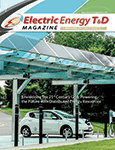Recent examples of lower probability, high-consequence events affecting the electric utility industry are reshaping the way utility executives and board members must look at risk and the associated costs of mitigating risk. Events such as the 2011 nuclear disaster at the TEPCO Fukushima Daiichi facility in Japan, the 2013 sniper attack on the PG&E Metcalf, Calif., substation and the 2015 cyber-attack on the Ukrainian electric grid, are just a few incidents that reflect non-traditional events which compound the already complex task of mitigating the risk of damage to critical electric assets from traditional sources such as severe weather, seismic events and fire, to name a few.
As a result, these new and emerging risks from unconventional sources are introducing a paradigm shift in the way utility executives address risks, old and new. Industry teaming is one new approach electric utility executives are considering.
It is critical to first form the proper level of understanding and urgency among the utility company board and C-suite executives to generate the increased focus and support that the business needs to address these new risks. Replacing damaged assets that have very long lead times, high capital cost and are critical for providing reliable service to customers must be understood as a top priority. Advances in technology require better education at all organizational levels and across organizational silos with regard to physical and cybersecurity threats, particularly as Internet of Things (“IoT”) technology and interconnected devices become more integrated, accessible and understood as imaginable threats and no longer “Black Swan” events. Business leaders need to have specific knowledge and should ensure regular business updates with respect to “critical” assets and systems − those for which a failure could create significant customer outages and/ or high expenses. Specifically, the company definition of “critical” needs to go well beyond the narrow definition that NERC CIP utilizes and which may not reflect actual assets that have high consequential risk.
Electric utilities are not the only industry segment that is taking notice. Insurance underwriters of electric utilities, for example, have taken action by reexamining their approach to policy design, pricing and risk-tolerance strategies. Underwriters are evolving in how they assess risk and quantify damage from the potential loss of long lead time critical assets such as high voltage power transformers that can cost well over a million dollars and can take up to two years or more to manufacture and transport.
Insurers are also considering the changes required to long-term business interruption coverage triggered by such events. Cyber-specific insurance is a rapidly growing offering and is becoming an increasingly important part of business risk management, alongside the utility’s property & casualty and business interruption policies. “The greatest concern for insurers, however, is that the risk itself is not constrained by the conventional boundaries of geography, jurisdiction or physical laws.” (Lloyd’s Emerging Risk Report – 2015). Still being determined is how each type of insurance policy interacts and responds to a cyber vector attack that damages or destroys physical property and leads to significant operational downtime and financial impact.
Meredith Schnur, Senior Vice President of the Professional Risk Practice at Wells Fargo Insurance, describes the challenge of “understanding the totality of a company’s insurance program, as more than one insurance policy could be triggered as a result of a cybersecurity incident.” Relative to physical damage to utilities’ operating technology and assets, Ms. Schnur adds, “Most cyber liability policies exclude liability arising out of any injury relating to bodily injury or property damage; cyber is a pure financial loss risk transfer product. One would assume the property policy would cover property damage arising out of a cybersecurity incident, when in fact, there are only a few property insurers who address this exposure under their existing policies. First-party business interruption loss arising out of a cybersecurity incident is evolving as we speak, but today, in the U.S., the coverage is not as robust as it needs to be to protect power and utility types of risks.”
Every electric utility is responsible for bearing the entire risk of loss and the cost of replacing an asset, should that be required. Historically the electric utility industry leaned toward asset optimization versus industry standardization, creating a diverse and often utility-specific set of equipment designs. As there were no driving industry utility company-specific efforts for standardization, the current installed base of high voltage electrical equipment across the United States does not readily lend itself to a common stocking one-size-fits-all approach. This industry dynamic has presented an expensive and difficult ‘sparing’ model for critical assets. Due to this, many utilities have some critical operating assets that do not have spare replacements available in storage, and often any spares held are not maintained or secure. The current, replace-or-fix-upon-failure strategy and independent business self-supply models remain risky and present a threat to the U.S. electrical grid system’s overall reliability and emergency recovery time.
Most of the bulk electric power grid was built around traditional, coal and nuclear base load power generation plants. Many of these older plants face the risk of retirement with renewable (wind, solar) and natural gas fuel plants replacing them. This adds new technical risks to assets remaining on the system and makes customers more vulnerable to grid instability and potentially long interruptions from a catastrophic event. According to the Energy Information Administration (“EIA”), 94 coal-fired power plants closed in 2015, with the capacity of nearly 14,000 megawatts. Another 41 coal plants are scheduled to close in 2016, with a combined capacity of more than 5,000 megawatts. Additionally, since October 2012, U.S. nuclear plant owners have closed or announced closure of 14 reactor units at 11 plant sites. All indications suggest that given the age of the U.S. coal fleet, nuclear plant closures, the transition to natural gas, and the growth of renewables and distributed generation, the U.S. electric grid will undergo enormous changes in the decade ahead. This will require electric utilities and transmission owning entities to evaluate their current asset management and critical spare strategies and make adjustments in their approaches.
Since many critical assets have been in service for many years, warranty protections are no longer in place, adding to the potential risks and costs if a significant event damage any of these. It is unreasonable to assume or expect that individual electric utilities will be prepared by maintaining a complete, duplicate inventory of very expensive critical spares. Industry teaming may be an approach to alleviate these concerns.
General Electric’s (“GE”) Aeroderivative Lease Pool program in the power generation space is an example of an industry teaming model. Participants pay an annual membership fee that offers an alternative to investing in expensive capital spare components while providing a guarantee on asset availability should an unplanned need arise. This program provides the dual benefit of standardizing critical asset types across the industry and reducing costs associated with expensive one-off replacements.
Another approach to risk mitigation and asset management strategy for electric utilities is the formation of Grid Assurance, LLC. Grid Assurance was developed through a collaborative effort of several utilities and was formed with the purpose of providing member companies a cost-effective way to improve the resilience of their bulk electric system assets as a whole, by offering access to an inventory of critical, long lead time equipment stored in secure warehouses and readily deployable to respond to a major system failure. The companies currently involved are American Electric Power, Berkshire Hathaway Energy, Duke Energy, Edison International, Eversource Energy and Great Plains Energy.
The chief executive officer of Grid Assurance, Mike Deggendorf, said, “Grid Assurance was formed to provide an industry-led solution to the emerging risks to resiliency. These are emerging and catastrophic events that need a new risk mitigation capability. Grid Assurance is focused on increasing the capacity and capability to quickly recover from these events with the substantial cost savings that comes from pooling of resources.”
By partnering with the Grid Assurance organization, utilities become part of a team working together to plan and develop a strategic asset reserve base. Additional services could emerge, such as pre-engineering, raw material stocking and options for prioritized allocation of emergency manufacturing slots with key suppliers. Additionally, Grid Assurance will perform ongoing logistics planning and will maintain expertise in large asset transportation, including intermodal transportation for inbound and outbound inventory. Where appropriate, it will also arrange for subscriber access to specialized transportation equipment (e.g., Goldhoffers, Schnabel cars, deck barges, dedicated boats, low boys, and cranes). Grid Assurance will manage its inventory so that manufacturer warranties are preserved.
Utilities have often been viewed as slow to adapt to change, yet today’s risks require boards and C-suite executives to challenge the status quo and adapt to these rapidly changing and adverse scenarios. Lisa Barton, Executive Vice President for AEP Transmission states, “There are clearly new, emerging risks for which the industry needs to prepare. Balancing the increased capacity for grid recovery, with the cost to customer and risk to the shareholders, is the challenge. Our customers, regulators and shareholders expect us to prepare for these risks, and Grid Assurance effectively balances all of these issues.”
Forward-looking utility executives will recognize the need to balance the complexities of leading and surviving in the current, more challenging and risk-laden world. Industry teaming should be considered a key component of a utility’s risk mitigation strategy. Participation in such groups should also be welcomed by utilities’ insurers as a risk mitigation factor and should be integrated into policy renewal efforts.
With each passing day, the U.S. electric utility client base becomes more reliant on a dependable, resilient and efficient electric power grid. The ability for electric utilities to immediately respond and restore critical electric power service is essential and will require innovative approaches and collaborative efforts across the industry to ensure maximum success.
The views expressed herein are those of the author(s) and not necessarily the views of FTI Consulting, Inc., its management, its subsidiaries, its affiliates, or its other professionals.
About the Authors
 Ellen S. Smith, P.E. is a Senior Managing Director at FTI Consulting, based in Boston. She works within the Economic Consulting segment, specializing in business advisory and litigation support services. Ms. Smith’s areas of expertise include matters involved in power reliability related damages, utility regulatory strategy, emergency response and strategic communications. She is currently providing advisory services with respect to all aspects of utility operations for a client who is going through restructuring. Prior to joining FTI Consulting, Ms. Smith was the Chief Operations Officer and Executive Vice President at National Grid, in Waltham, Massachusetts.
Ellen S. Smith, P.E. is a Senior Managing Director at FTI Consulting, based in Boston. She works within the Economic Consulting segment, specializing in business advisory and litigation support services. Ms. Smith’s areas of expertise include matters involved in power reliability related damages, utility regulatory strategy, emergency response and strategic communications. She is currently providing advisory services with respect to all aspects of utility operations for a client who is going through restructuring. Prior to joining FTI Consulting, Ms. Smith was the Chief Operations Officer and Executive Vice President at National Grid, in Waltham, Massachusetts.
 Donald Racey is a Managing Director in FTI Consulting’s Economic Consulting segment and is based in Pittsburgh. He is part of the Energy, Power and Products industry practice. He has more than 20 years of experience leading large-scale operational transformation engagements. He specializes in the design, development and implementation of Operational Excellence, Process Improvement and Merger & Acquisition Integration programs.
Donald Racey is a Managing Director in FTI Consulting’s Economic Consulting segment and is based in Pittsburgh. He is part of the Energy, Power and Products industry practice. He has more than 20 years of experience leading large-scale operational transformation engagements. He specializes in the design, development and implementation of Operational Excellence, Process Improvement and Merger & Acquisition Integration programs.







